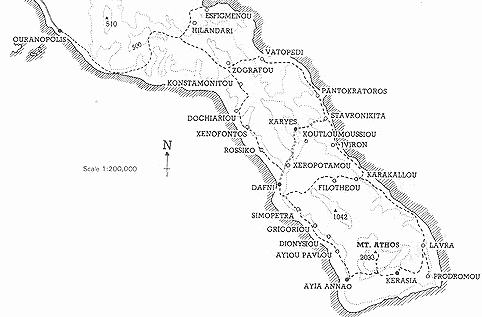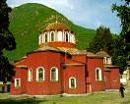Mount Athos

On the fringes of the Aegean, on the fringes of Macedonia, a rocky land with no hospitable
harbors, covered with dense, wild vegetation, hostile to the human presence, shut in by restless, foaming waters, cut off from the rest of the mainland, cut off from the transience of daily routine
and the things of this world.
On the fringes of history - and itself history - a land traveling through the centuries like an Ark. Indestructible, contemplating the still-born regenerations and the chained revolutions of the times. Young and fine and so old. Wise and yet so child-like. Lonely and alone.
On the fringes of the conscience, the Holy Mountain, the Garden of the Virgin. Five to ten kilometers wide and about fifteen long, touching, at two thousand meters, the boundless heavens, in direct communion with the divine. An earthly paradise, dedicated to the glory of the Son of Man, nestling in the arms of the Mother of God, a place to exercise the body and the soul, a piece preserved unsullied from the time of Creation.
The beginnings of monastic life on Mount Athos belong to the sphere of myth.  Although
some of the sources - the "Patria" or "Proskynetaria" - date this phenomenon to the reign of Constantine the Great and his mother Saint Helen, the first hermits seem to have come to Athos in the 7th century A.D.,
having been displaced from Egypt and the East, which at that period were being seized by the Arabs. It is a historically attested fact, however, that the peninsula was first designated a place of Quietism
by a chrysobull of Basil I in A.D. 885. The founder of cenobitic monastic life there is thought to have been Saint Athanasios of Trebizond who, with the support of his friend the emperor Nikephoros Phokas (A.D. 963-969),
founded the Great Lavra, the first monastery on the peninsula (A.D. 962/963).
Although
some of the sources - the "Patria" or "Proskynetaria" - date this phenomenon to the reign of Constantine the Great and his mother Saint Helen, the first hermits seem to have come to Athos in the 7th century A.D.,
having been displaced from Egypt and the East, which at that period were being seized by the Arabs. It is a historically attested fact, however, that the peninsula was first designated a place of Quietism
by a chrysobull of Basil I in A.D. 885. The founder of cenobitic monastic life there is thought to have been Saint Athanasios of Trebizond who, with the support of his friend the emperor Nikephoros Phokas (A.D. 963-969),
founded the Great Lavra, the first monastery on the peninsula (A.D. 962/963).
A few years later in A.D. 971/72, at the instigation of the emperor Ioannis Tzimiskes (A.D. 969-976), Euthymios, the Abbot of the Studite monastery in Constantinople, composed the first typikon (a charter governing the organization and administration of the Athonite State). This text, known as the Tragos (because it was written on a parchment of a goatskin, tragos=goat), and now housed at Protaton (the katholikon at Karyes, the capital of the Athonite State, formed the basis for the later typika and the subsequent development of all the monasteries on Mount Athos. It has been claimed that the intervention of the state in the creation of a monastic polity was dictated mainly by the spiritual need for the Byzantine Empire to become more involved in the Balkans, with a view to defending and strengthening the Orthodox Church after the conversion to Christianity of the South Slavs and the Bulgars (A.D. 864/65), and in response to attempts by the Roman Catholic Church to penetrate the spheres of influence of the Eastern Church. The eminent men of the cloth who took an active part in the enterprise, the personal interest shown by members of the imperial family, and the fact that from as early as the 10th and the beginning of the 11th centuries A.D (A.D. 965 ff.), Amalpheni (A.D. 981), Slavs, Russians and Bulgars flocked to Athos to man the new monasteries, were all factors leading to the place acquiring an ecumenical character and becoming a crusading center for the True Belief.
These were the years of "Romiosyni" and the establishment of a Greek-Orthodox consciousness, during which the great monasteries were founded (the Great Lavra, the monastery of Vatopedi and that of Iveron), and the foundations were laid for other, smaller monasteries (those of Docheiariou, Xenophontos and Philotheou). From these times, and from the period of generous royal gifts of huge landed estates, of domes decorated with gold, of richly adorned katholika and of echoing cells - multi-story, fortress-like defensive structures - down to the enslavement of the nation by the Turks, Mount Athos knew moments of grandeur and of decline. Periods during which monasticism thrived and new monasteries and annexes were built (11th/12th and second half of the l4th centuries), and difficult times of abandonment and pillaging (13th and beginning of the l4th centuries), during which the undefiled mother of endurance - the immaculate Mother of God - enfolded the inner sanctum of her house in love and tenderness.
Mount Athos became acquainted with the Franks of the Fourth Crusade, the oppression of Michael VIII Palaiologos, a fervent supporter of the Unification of the Churches, and the plundering invasions of the Catalan pirates. It was also the object of the active interest of the emperors of Trebizond and the kings of Serbia.
Faced with a "fait accompli," the monks were reconciled with the Ottoman conqueror and during the first half century or so that followed their subjection to the Sultan, they retained the privileges they had been granted by the Byzantine emperors. One indication of their prosperity was the renovation, at about the middle of the l6th century, of the Monastery of Stavronikita (1536)and the decoration of a large number of katholika, refectories and chapels by named painters of the period (Theophanes the Cretan, Tzortzes and Frangos Katelanos).
Fresh buffetings, however, lay in wait for the ship of the Orthodox faith in the stormy ocean of the three centuries that remained before liberation: swingeing taxes and confiscations of estates led to the abandonment of monasteries, to the replacement of the cenobitic way of life by the "idiorrhythmic" and to the foundation of scetes, and spiritual unity was undermined by religious strife. Even in these moments of adversity, however, the spirit succeeded in achieving great things and producing a host of scholars and wise men of the stature of Nikodemos of Naxos, Eugenios Voulgaris, Kosmas Aitolos, Athanasios of Paros - all teachers and pupils at the famous "Athonite School."
The territory of the Athos Peninsula is now an integral part of the Greek State, though it is self-governing, on the basis of a special charter (Treaty of Lausanne, 1923), and is distributed between the twenty sovereign monasteries, which follow a traditional hierarchy based on their imperial titles and other privileges. Monasteries to which the centuries have bequeathed rare examples of illustrated manuscripts and codices, brilliant wall-paintings, silver-clad icons of saints, and clerical vestments studded with precious stones, endowing them with imperial gifts, imposing buildings, boat-houses and scetes, old peoples homes, hospitals, kathismata (a kind of monastic building), and hermitages. Beacons and bastions, safe harbors, refuges of the soul and the spirit.
For Greeks, Mount Athos is the cradle of their national traditions and a part of Greece that for over a thousand years has preserved their Greek-Christian traditions, literature and authentic Byzantine worship. It is a sacred repository housing still unknown sources for scholars investigating theology, philosophy, history, Byzantine and post-Byzantine art and eastern mysticism, and a boundless museum containing invaluable treasures and heirlooms of the Orthodox tradition.
Karyes
The Monastery of Konstamonitou
The Monastery of Docheiariou
The Monastery of Xenophontos
The Monastery of St. Panteleimon
The Monastery of Xeropotamou
The Monastery of Simonopetra
The Monastery of Gregoriou
The Monastery of Dionysiou
The Monastery of St. Paul
The Monastery of Great Lavra
The Monastery of Karakalou
The Monastery of Philotheou
The Monastery of Iveron
The Monastery of Koutloumousiou
The Monastery of Stavronikita
The Monastery of Pantokrator
The Monastery of Vatopedi
The Monastery of Zographou
The Monastery of Esphigmenou
The Monastery of Chelandari